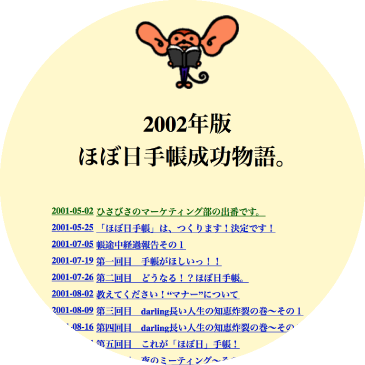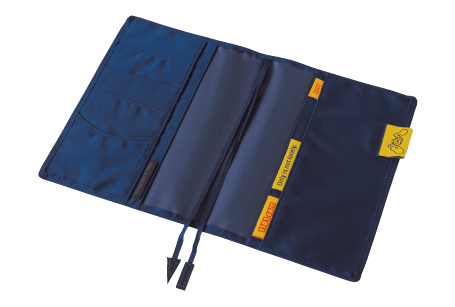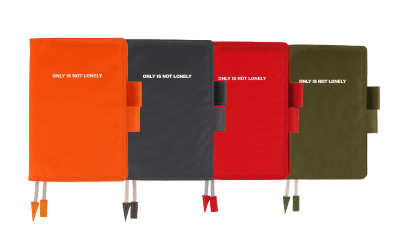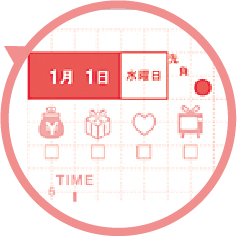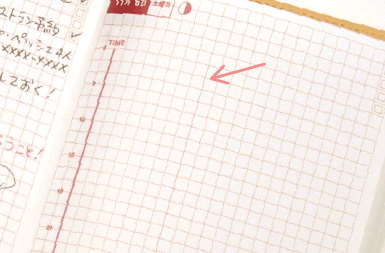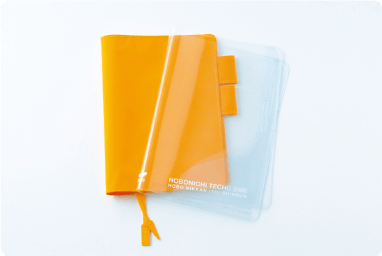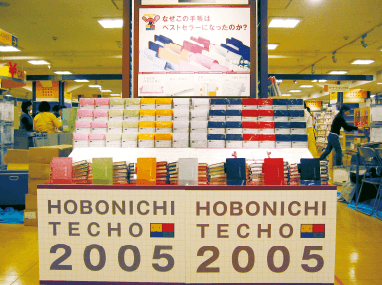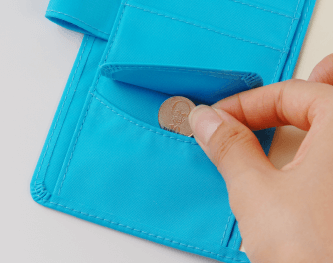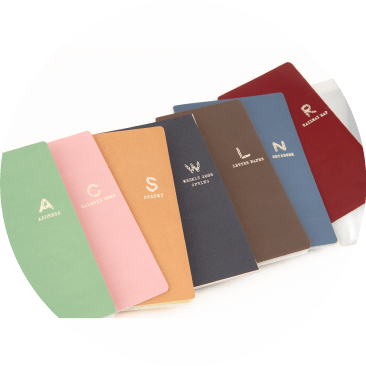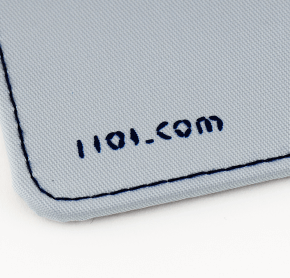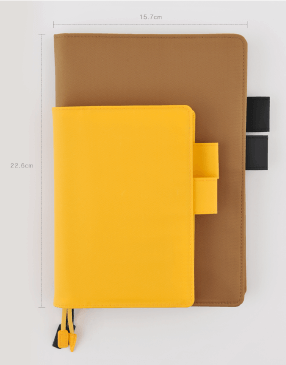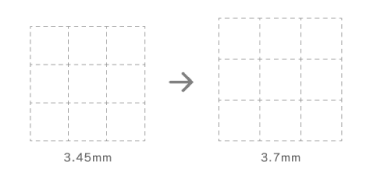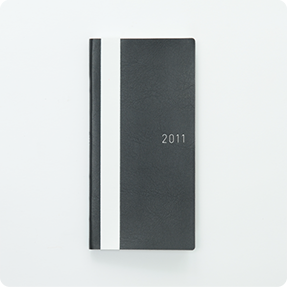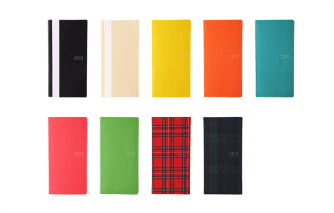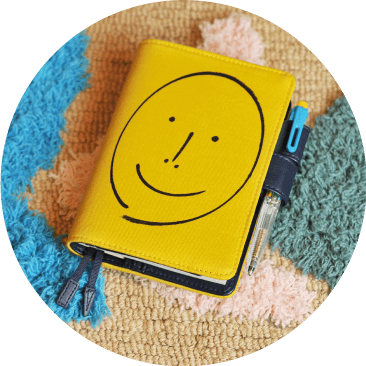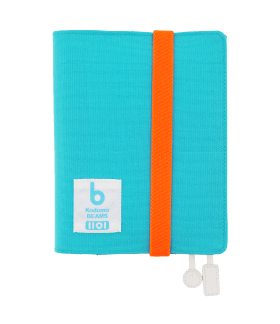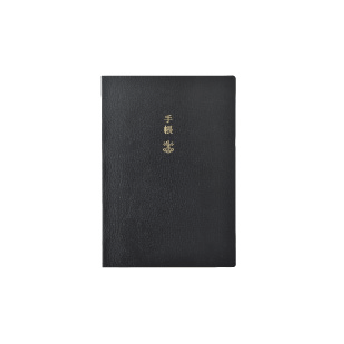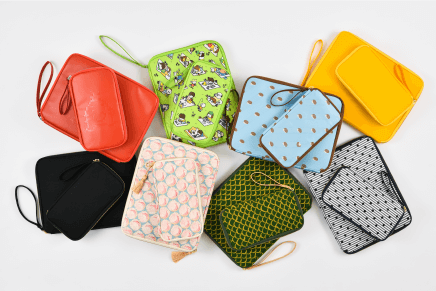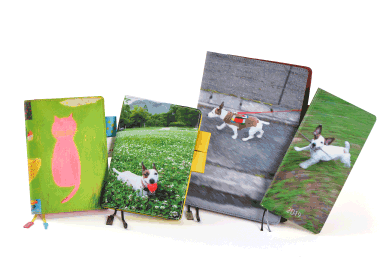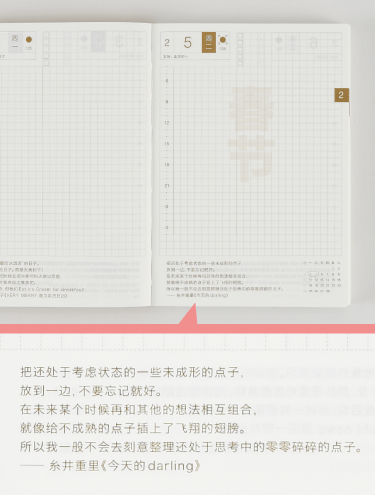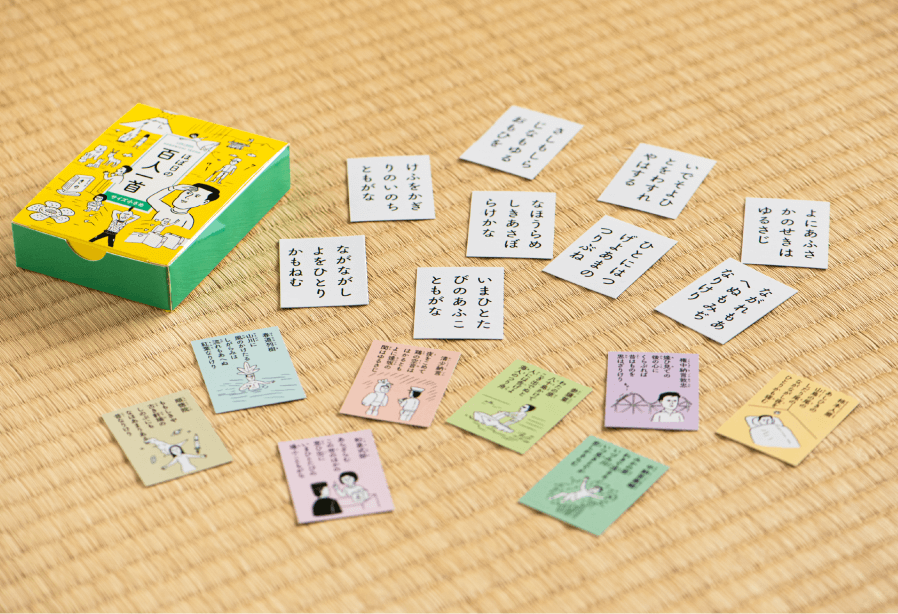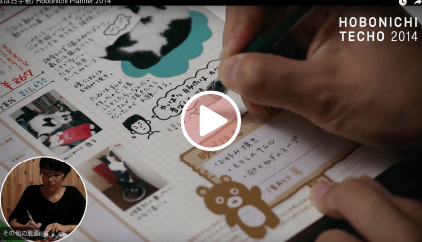
The Hobonichi Techo was born from the website Hobo Nikkan Itoi Shinbun, started by Shigesato Itoi in 1998. In the spring of 2001, the idea of a Hobonichi Techo was originally presented during a development meeting exploring original goods for the website. When we polled our readers to ask who would be interested in a Hobonichi planner, over 700 respondents answered with a resounding “yes,” greenlighting the Hobonichi Techo project.
The team sat down to design a planner they would genuinely want to use themselves. Working completely from scratch, without using any other planners as a reference, they brought a planner with its own unique characteristics to life: The first version of what is now the Hobonichi Techo Original.
Already the book had many characteristics of the techo: It was an A6-size page-a-day planner with thin-yet-durable Tomoe River paper that allowed for its slim construction. Each month was printed with different-colored ink, pages featured a quote at the bottom, and handy bonus pages in the back offered a variety of content. Lay-flat binding allowed it to sit completely open on a desk, and it fit nicely inside a cover with lots of useful pockets.
From the very first year, the Hobonichi Techo had many of the special characteristics that define it today. The only cover available for this first year was a nylon navy cover with two attached bookmarks.
After an overwhelmingly positive response to the first Hobonichi Techo, the next year’s edition was approved to move forward in April 2002. In response to user feedback, the size of the graph paper was increased from 3 mm squares to 4 mm. Among other improvements, the timeline on the daily pages was redesigned, the quotes on the bottom of the pages were expanded, and the yearly calendar and yearly schedule (now called the yearly index page) were added.
The cover choices increased to 4 color options, with each cover silk-screened on the front with the text “Only is not lonely.” This was also the year the cover gained its trademark pen holders — they’re called “butterfly clasp” in Japanese, as they resembled butterfly wings and were designed to hold the book shut. Many covers in today’s lineup still include this recognizable feature. The free pen included with the 2003 techo was a big hit, making bonus items an annual feature that continue to this day.
After many customer requests, we added a leather option to the cover lineup, with three color options, alongside five nylon covers. The covers were improving alongside the books: This year the covers gained their popular outer pocket, and nylon covers received their water-repellent finish for the first time.
The techo’s daily pages were updated to include the “secret line,” a vertical dividing line that’s handy for those who’d like to use it, but is otherwise easy to ignore. The checkboxes were simplified, and this was also the first year that daily quotes were included for each of the book’s 365 days. These features are unique to Hobo Nikkan Itoi Shinbun’s special techo, and carry on every year.
This year, for the first time, the Hobonichi Techo was available to purchase at Loft stores. This was the first time customers were able to hold the techo in their hands before buying it. The Hobonichi Techo team contacted Loft and expressed their hope that the store would carry about 500 books; Loft ended up requesting 15,000! In the end, they ended up buying 17,000. From this year onwards, the Hobonichi Techo has been the No.1 seller in the planner division in Loft Stores.
The Cover on Cover, which expands the ways you can use your nylon cover, was also new this year. The cover itself was improved this year by the addition of the Ticket Pocket and an update to the placement of the pen holders.
This year brought the first official guidebook, which outlined the wide variety of ways that users had found to integrate the techo into their lives. The 2006 cover lineup included a “Super Rainbow” of 11 colors. A monthly calendar was added to the daily pages for the first time, and a two-day-per-page section at the start of the book was added to allow users to start their book in December, a feature that continued through 2015.
2006 was the first year for the April-start Hobonichi Techo Spring, which we introduced after lots of customer requests, and our first time using the Hobonichi Techo slogan “Happy Nothing Special Day!” Many Hobonichi Techo accessories also joined the lineup this year.
Now in its sixth year, the techo finally gained a patterned cover series, called “Faux Fabric.” Houndstooth, plaid, and striped clothing-inspired designs were printed onto polyester covers. Before the Faux Fabric series covers had all been solid colors, but the number and variety of designs has exploded ever since. We also made some improvements to the interior of the covers, adding more card pockets and making them wider.
2007-edition “Wallet Techo” covers featured a flap over the bottom card pocket, but the feature only lasted one year. A new feature called “Hobonichi Techo Club” was added to the official website to host usage examples and announcements; it’s since been incorporated into the Hobonichi Techo Magazine
Two-tone covers appeared this year. These new nylon covers featured a second, contrasting color on the outer pocket. These designs may seem subdued now, but at the time they were seen as a refreshing change! This year’s lineup included 20 cover designs. Back then, the logo changed every year, and 2008-edition covers featured a logo by the knitter Tomoko Takamori.
The techo book received a number of subtle improvements this year. Weekdays and weekends were printed in different colors, and weeks were numbered on the monthly calendars. The Hobonichi Weekly Calendar, the Hobonichi Railway Map, and other add-ons received unified designs and were gathered into a collection of 10 accessories called Fine Tools, a collection that eventually evolved into Tools & Toys. A free trial version, with one month of pages, was available this year, and many people tried it.
2009 was a year of big changes. The A5 Cousin joined the A6 Original book for the first time, but this first year of the Cousin lacked daily quotes in order to give the large pages even more writing space. A long-awaited Sunday-start version was added to the A6 lineup.
Graphic designer Taku Satoh oversaw a number of refinements to the book’s design — while the changes were major, they were difficult to spot at a glance. The graph paper squares were reduced in size from 4 mm to 3.45 mm and eliminated from behind the date at the top of each page; the criss-crossing dotted lines were redrawn to meet evenly at every intersection.
Fabric covers joined the lineup for the first time in 2009, including a linen herringbone. Magazine House published this year’s official Hobonichi Techo Guidebook, which has been offered every year since.
The biggest change for 2010 was a huge expansion of the cover lineup. We challenged ourselves to make a new cover every month, and ended the year with 54 total designs. This year marked the start of the high-end Henry Cuir leather cover series as well as the World Folk Patterns series. We also released popular collaborations with companies like Morikage Shirt, Desertic, and Hobonichi’s bear brand, OHTO.
After running surveys and holding round-table discussions with users, the graph paper size was finalized at 3.7 mm. Users of the Cousin, now in its second year, told us they missed the daily quotes, so we offered a separate book that collected all of them.
For the Hobonichi Techo’s 10th anniversary, we introduced the Weeks as a way to encourage people to use a Hobonichi Techo at work. The book was the size of a long wallet, and designed to be light and portable. To accommodate this smaller size, the graph paper shrank back to 3.45 mm. The Weeks only came in the black “White Line” design and did not contain any quotes.
Several more collaborations joined the 58-cover lineup for Original and Cousin, including mina perhonen, Disney, and Porter. The position of the covers’ interior pockets moved this year, making them more comfortable to use. Among other small changes and improvements, the 24-hour timeline on each page was split into 30-minute increments and color was added to weekends in the yearly index page, which continued until 2014. Finally, the Cousin included daily quotes for the first time.
The theme for this year’s techo was “Smile.” The Hobonichi Store exclusives included a small pocket mirror with a smile printed on the surface. 2012’s featured cover, a bright yellow design also called Smile, showcased a sketch by mina perhonen’s Akira Minagawa. This year’s fun cover lineup included collaborations with Disney, sunui, Makino Collection, and Liberty, as well as the debut of the pouch-like Zippers covers. Zippers covers offered users a secure place to store important items, giving the techo more opportunities to shine. In its second year, the Weeks was now offered in 11 designs, including bright colors and even plaid.
Following the 2011 Tohoku earthquake, we replaced damaged and lost techos and covers for free.
Sonya Park of Arts & Science directed the all-new English version, “Planner.” A member of the Hobonichi Techo team had originally contacted Sonya about collaborating on a cover; she agreed to design the cover, but also expressed her interest in producing an English version of the book.
The English Planner was created as a simplified and refined version of the Japanese techo. When the Hobonichi Techo was first created in 2002, the team joked that they wanted to make the best techo in the world. Now they felt a little closer to achieving that dream. The cover lineup contained a record 85 designs, including the “& Child” cover for mothers. The corners of the techo books were rounded, making them harder to crease.
The cover lineup continued to grow in 2014, with a record 98 designs. This year’s theme was “I’m having fun this year.” Children’s book artist Ryoji Arai’s cover “I'll listen to you anytime, says the donkey,” Kodue Hibino’s cover “Forest Bear,” Taro Okamoto’s cover “Construction,” “Field Pack,” by the North Face, and “Vintage Mickey,” with its giant print of the face of a Mickey plush doll, were just a few of this year’s many striking and unique covers.
This year we held a Hobonichi Techo Slogan Contest. Shigesato Itoi spent two days reviewing all 13,104 entries. The grand-prize winner was Yoko Tatsumi from Aichi prefecture, who submitted the slogan “If they recommend this to you, they must like you.” Designer Yugo Nakamura created a fun short video about techo users.
For the first time, the official Hobonichi Techo web page was available in English, making it easier for overseas customers to shop.
An unusual new version of the Cousin and Original techos arrived this year in the form of the Hobonichi Techo Avec, a book that splits the year in two — January to June in the first book, and July to December in the second. The smaller books delighted users who wanted a lighter techo as well as those who wanted to fill their pages with bulky objects.
There were some new cover varieties as well, like the silicon SSACK, the fluffy Faux Fur, Shoko Nakagawa’s mmts, and Naoki Ishikawa’s Himalaya. This year marked the start of the Mother cover series, based on the video game created by Shigesato Itoi. The collaboration was a big hit, and Mother covers are now an annual favorite.
After much thought about how to define the Hobonichi Techo, Shigesato Itoi penned the nickname Life Book. The Shibuya Loft hosted 2015’s release event, which included an exhibition in which 21 people answered the prompt “Life is…” 2015 was also the year that the English website included a page explaining the Hobonichi Planner in greater detail.
Photographer Kawashima Kotori kicked off the 2016 Hobonichi Techo lineup with the trailer, “This is my LIFE.” Covers included a half-moon-shaped cover by the fashion brand Anrealage and a cover with traditional Kogin-zashi embroidery, a collaboration with Hello Kitty, Okamoto Taro’s “Tower of the Sun,” and a Weeks cover by Kyoko Okazaki, for a total of 87 designs.
This year #hobonichi became a popular hashtag on Instagram, making it easier than ever for us to see the Hobonichi Techo’s growing international user base. We also held a meet up with 60 Hobonichi Techo users, allowing us to see how they use their techos and hear first-hand about their experiences. The official Hobonichi Techo website was offered in a mobile version for the first time, improving the shopping experience.
This year’s techo covers were as colorful as ever, with one by Sebastian Masuda and another entitled Snow Peak. We held a poll to see which World Folk Pattern design users wanted to see reprinted, and the winner, Ukrainian Flowers, returned as part of the 2017 lineup.
2017 also marked the start of our regularly occurring “Meeting Caravan,” which travels across Japan to meet with users and talk about the Hobonichi Techo. Meet ups are held every other month, and even occasionally take place overseas.
We were delighted to see the Traveling Hobonichi project, which was organized independently by Hobonichi fans. A single Hobonichi Techo was sent around the world to 36 users, and each one made an entry in the book before passing it along. Hobonichi Techo meet ups were also organized in countries such as China and the Philippines. We were amazed by all this new activity; in an interview, Shigesato Itoi described the bustle of activity by saying, “The ship has left the port.”
Hobonichi Co., Ltd was listed on the stock market this year, further expanding the reach of the Hobonichi Techo in its 17th year. Many new items were introduced to the lineup, including the Hobonichi Techo Weeks Mega, with three times the number of blank memo pages in the back. This provided a host of new ways to enjoy the Hobonichi Techo Weeks.
The all-new Hobonichi 5-Year Techo was also a hit upon release, and TV shopping network Japanet Takata’s former president Akira Takata liked the product so much he sold it on his television program. A new partner to the Hobonichi Techo also joined the lineup: the Drawer Pouch.
Children’s book author Shinsuke Yoshitake illustrated this year’s informational booklet included with orders, and his illustrations were such a hit that he was brought back on to design a Hobonichi Techo Spring-edition cover. The year’s string of big news ended with the announcement that the Hobonichi Techo had begun official sales in China.
The Hobonichi Techo reached its 18th year. After releasing the Hobonichi 5-Year Techo the year before, the A5-size “Large Hobonichi 5-Year Techo” also joined the lineup this year. In addition, the Simplified Chinese version Hobonichi Techo was the latest addition to the techo family as a product exclusive in China. The cover lineup had a total of 103 designs, including special collaborations with Doraemon and Can You See What I See, and a new cover series featuring Shigesato Itoi’s beloved dog Bouillon. The new Drawer Pouch series was also a big hit. We also held a Gratitude Tour this year, in which Shigesato Itoi visited people and places involved in every aspect of making the Hobonichi Techo possible.
The biggest Hobonichi news for the 2020 edition was the release of the Day-Free monthly notebook. It’s a totally new take on the techo with its focus on monthly calendars and blank memo pages. Additionally, the Dancing Fox cover made in collaboration with creator Aki Kondo, and the Ochitsuke cover with the words "stay calm" that Shigesato Itoi holds dear to his heart written on the cover by calligrapher Kyuyoh Ishikawa made an appearance. Other projects include chocolates created through a collaboration with German plush toy maker Steiff. We asked chocolate patisserie Theobroma in Shibuya, Tokyo to create chocolates to enjoy three flavors, to match the 2020 Steiff collaboration theme "Trinity."
The Hobonichi Techo turned twenty with the 2021 edition. We introduced the BS Lite cover to be used with the Day-Free that made an appearance the year before. The lineup also included the Japan Manga Classics covers that were made in collaboration with Astro Boy, Doraemon, Ranma 1/2 and Chibi Maruko-chan, as well as collaborations with MOTHER and Sesame Street. Additionally, we made the Simplified Chinese A5 Cousin Hobonichi techo sold exclusively in China, as well as items that can be used with the techo, such as the Weeks Case - Mokku and the Hobonichi Sacoche Mate. This was also the year where all Hobonichi crew members used the Hobonichi Techo starting in April as many worked from home with the spread of the novel coronavirus. It was an opportunity to face the act of writing by hand and putting things into words.
We continued on with the manga series from the 2021 edition to create Rumiko Takahashi’s Inuyasha techo cover, Weeks book and accessories. Additionally, as the Hobonichi office moved to Kanda, Tokyo in November 2020, we created techo covers and Weeks books under the theme of Kanda. There’s more to choose from the 5-Year Techo covers too, with covers such as those by minä perhonen joining the lineup. We introduced the Simplified Chinese Weeks book, too! We will continue to develop from our 21st year onwards.


